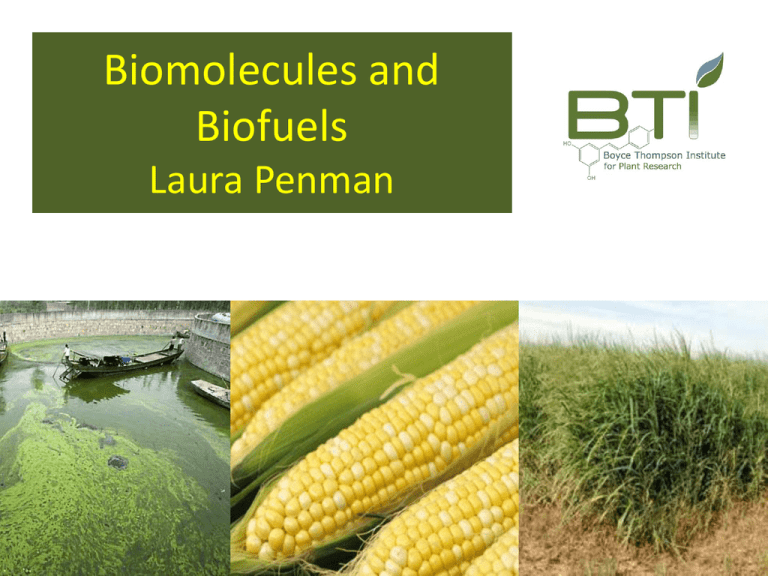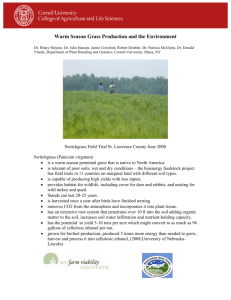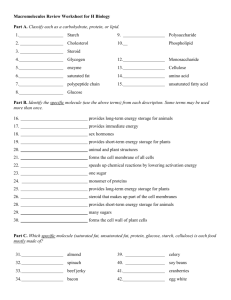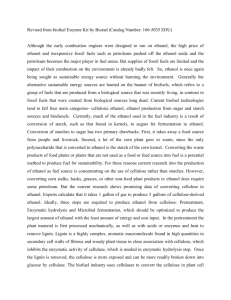Biomolecules and Biofuels
advertisement

Biomolecules and Biofuels Laura Penman Q. Why Biofuel? What are the sources of biofuel? • A Biofuel can be any renewable organic molecule that releases usable energy – Renewable: able to be generated repeatedly – Organic: based on carbon skeletons » From living things or once-living things Four different kinds of organic molecules • Carbohydrates – Sugar-based (starches, glycogen, cellulose) • Proteins – Amino acid based (actin, keratin, collagen) • Lipids – Don’t mix well with water (oils and fats) • Nucleic Acids – Nucleotide-based (DNA and RNA) Molecules can be put together OH HO H O-H O Dehydration Synthesis!! Molecules can also be broken down O H O-H OH Hydrolysis HO Note that water (H20) is involved in both! • Dehydration synthesis removes H+ and OH- from two different molecules to synthesize (put together) a polymer • Hydrolysis uses a water molecule to split (lyse) a big molecule into two smaller ones Connections to biofuel • Hydrolysis is often used to release energy from molecules (Dehydration synthesis is used to build complex polymers) Your body uses organic molecules as fuel Calorie : a measure of energy in a molecule • 9 calories /gram lipids • 4 calories/gram carbohydrate • 4 calories / gram protein So do your automobile engines • Biodiesel • Oil-based • plant or animal sources • Ethanol • Sugar-based • Plant sources Q. What is “ethanol”? • Aka. ethyl alcohol • Clear, colorless liquid • Flammable Q. How is alcohol/ethanol made? • By fermenting sugars – Fructose – Maltose – Sucrose What do you suppose “-ose” means? Q. How does the sugar get fermented? • By yeast, when oxygen isn’t present BASIC ethanol production Carbohydrate source sugars ethanol The challenge EASY Been there, done that Does ethanol production from carbohydrates involve Hydrolysis or Dehydration synthesis? BASIC ethanol production Carbohydrate source sugars ethanol The challenge EASY Been there, done that “Major players” in biofuel ethanol (NOT grape juice) • Corn sugars/starches • PRO: fermentation technique is established – Starchsugar ethanol • CON: $ to plant each year, irrigate, fertilize • Sugar cane • PRO: fermentation technique is established – Sugar ethanol • CON: doesn’t grow in the USA • Switchgrass and willow • PRO: native perennial to most of USA, easy to grow • CON: processing is not worked out yet – Cellulose-->sugar????? Which leads us to today’s lab… • Switchgrass (Panicum virgatum) --a low-cost and low-labor source of cellulose in this region – Perennial (harvest biomass yearly) – Minimal nutrient requirements – Able to handle a range of water conditions Cellulose is in the cell walls of each plant cell Cellulose Molecule Cellulose fibers Fiber Microfibers Cellulose + Cellulose + Plant cell Hemicellulose +Hemicellulose Lignin Switchgrass Cell wall Switchgrass provides a great source of biomass (potential fuel) • BIG organic molecules (like cellulose) are called polymers – Made from small subunit molecules called monomers Cellulose structure Cellulose is a chain molecule made of small units of glucose (sugar): Choose one: Cellulose is a monomer or polymer? Choose one: Glucose is a monomer or polymer? glucose A special chemical was found that breaks down cellulose polymers into glucose! AccelLerase • If we maximize this breakdown process, we will have plenty of glucose to ferment! • Your challenges are : – To determine what kind of molecule “accellerase” is (Part 1) – To determine the effect of pH on this process! (Part 2) • Accellerase is an organic molecule • You will learn which type in lab (Part II) – Indicators change colors in the presence of certain molecules • • • • Benedicts turns blue-- if it is a sugar Iodine turns black-- if it is a starch Biurets turns purple-- if it is a protein Sudan IV turns red-- if it is a lipid • What kind of molecule is Accellerase? Sugar Carbohydrate Test name Color of negative control Material in positive control Color or positive control Color of Accellerase after test Starch Carbohydrate Protein Lipid Maximizing “Accellerase” • What can we control in order to get the most “bang for our buck”? – Prepare experiment to study two factors • 1) • 2) pH size of switchgrass material Size of switchgrass material • Your group will be assigned one of the following types of switchgrass – Cut switchgrass leaves – Pelletized switchgrass leaves – Powdered switchgrass leaves Every group will examine the effect of pH on “accellerase” activity • Treatment series 1 (Tubes 1, 2, 3, and 4) – 4 tubes containing 15 ml of the following solutions pH 3, pH 5, pH 7, pH 9 – Add 5 g switchgrass to each tube – Add 0.5 ml Accellerase • Treatment series 2 (Tubes 5, 6, 7, and 8) – 4 tubes containing 15 ml of the following solutions pH 3, pH 5, pH 7, pH 9 – Add 5 g switchgrass to each tube – DO NOT add Accellerase pH ___3____ Switchgrass + Accellerase Switchgrass without Accellerase pH ___5____ pH ___7____ pH ____9___ ASSIGNMENT for next lab period: • Complete questions in handout for part I • Also form hypotheses regarding pH and pretreatment of switchgrass • Did accellerase increase glucose production? • Were the effects of accellerase similar for all pH levels? • Which pH helped accellerase work the best? Prepare a graph showing your results. • Based on your graph, which pH range would you want to test as you “iron out” the technique? “Accellerase” & Cellulose breakdown •Some enzymes are used by organisms to break down (digest) polymers (Other enzymes are used by organisms to build polymers) •Enzymes end with “-ase” •Cellulase enzymes can break down cellulose into its sugar molecules. Conversion of cellulose Cellulose molecule 1- The enzyme recognizes the cellulose molecule 2- The enzyme cuts the atomic bond 3- One molecule of glucose is released 4- The enzyme advances to the other unit The enzyme processes along the cellulose molecule Cellulase (enzyme) The cellulose is converted into fermentable sugars Enzymes are proteins The function of enzymes relies on their shape. Denaturation: permanent loss of enzyme function by permanently altering its shape Temperature – too high pH— too high or too low Biomolecule Review • Remember that – Ethanol is “sugar-based” – Biodiesel is “lipid-based” Source for ethanol or biofuel? Source for ethanol or biofuel? Source for ethanol or biofuel? Source for ethanol or biofuel? Source for ethanol or biofuel? Source for ethanol or biofuel? Source for ethanol or biofuel? Source for ethanol or biofuel?






